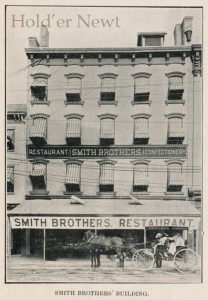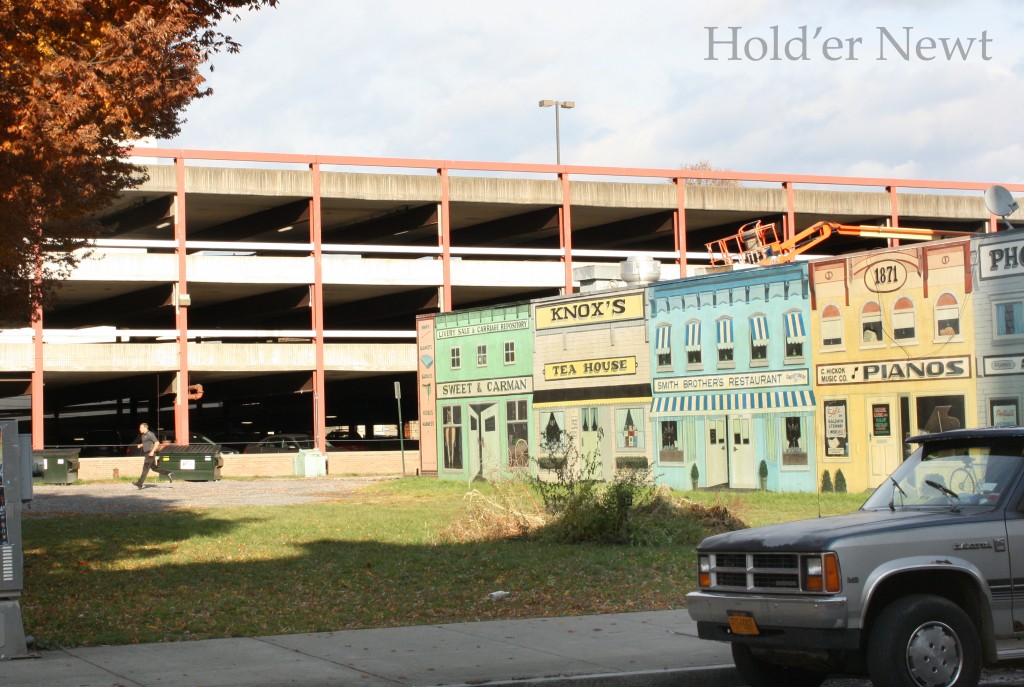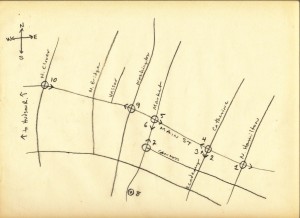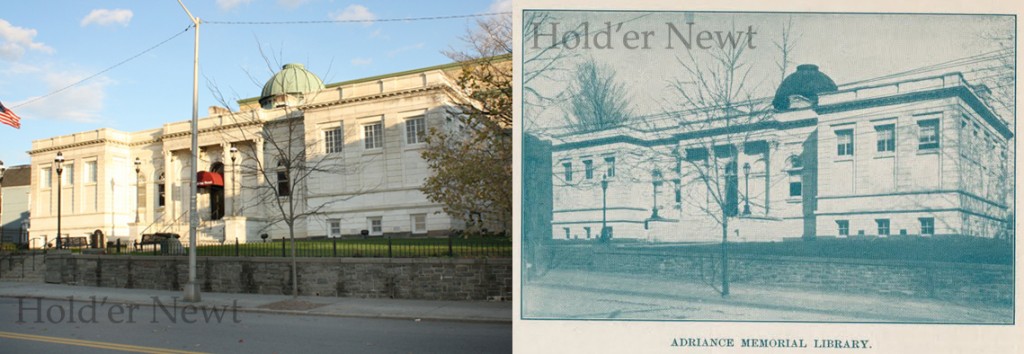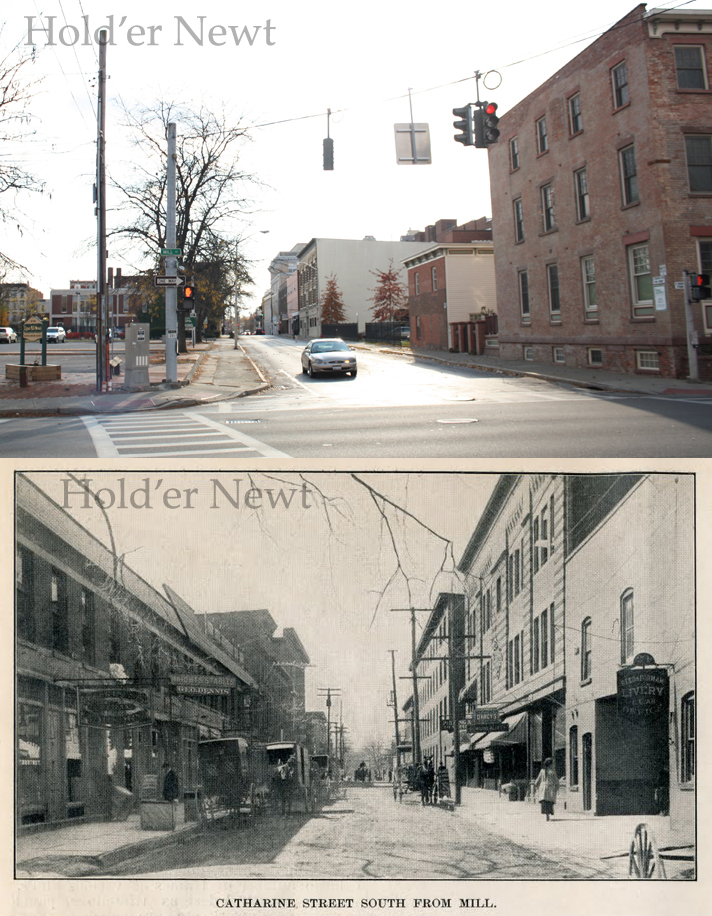Luckey Platt & Co department store, open for business in 1906
“LUCKEY, PLATT & CO., 332 to 344 Main Street, Poughkeepsie. Dry Goods, Carpets, Furniture, Wall Papers, etc. This business was started about the year 1845. From a modest business that required only a small store, the years have brought with them a success that has more than justified the firm in occupying the immense space they now use in carrying on their extensive trade. The present large proportions of the store have made it the largest in Poughkeepsie, in fact, by far the largest store on the Hudson river. The main building, an imposing structure of brick and terra cotta, was erected in 1901, and when completed was joined to the building already in use. Since that date by adding more stores, the firm now occupies something over 60,000 square feet of floor space. Not only is this store prominent in size, but it is equipped with the most modern fixtures, has in use three hydraulic elevators, four delivery wagons, besides outside cartage service. Storage buildings are also used for the accommodation of stock. The present title of the company has been in force since 1869. It now consists of Messrs. Edmund P. Platt and Smith L. DeGarmo, these two gentlemen being the sole proprietors of the store. There are twenty-six different departments, and about one hundred and twenty-five persons are employed.” (I&DP, p.22)
Because the Luckey Platt building was a bit further east of the largest sections of ‘blight’ and did not go out of business until 1981, the building still stands to this day, seen above in November 2011. “Numerous expansions saw the store swallow up several surrounding buildings in a drive to become the handsomest and most comprehensive department store between Albany and New York.” (DCHS p. 90) It was last expanded in 1923 by architect Edward C. Smith. This is the size and height the building still has today.
330-346 Main St, Poughkeepsie, NY today
Luckey Platt was in its day one of the largest and most popular department stores between Albany and New York City. After the 1950’s when people and industry started leaving the City of Poughkeepsie the store’s decline began. Other places to shop located closer to IBM popped up to compete with the downtown shops. Congestion from the explosion of automobiles on the scene also made it more difficult to find parking. One of the first malls to open in the area was the Poughkeepsie Plaza (Marshalls, etc) in 1958. Zimmer Brothers jewelry store which had a shop in the central business district moved just outside the city limits on Raymond Ave. and remained open but many other businesses closed for good. 41,000 people lived in the city limits in 1950. Today, there are just over 29,500.
 Main Street looking West with Luckey Platt on the south side of the street
Main Street looking West with Luckey Platt on the south side of the street
Luckey Platt’s patronage tapered off to 15 employees on the first floor of their massive building when it closed a day ahead of schedule with little fanfare on July 2nd, 1981. A few firms and individuals tried to make use of the space after Luckey Platt closed. In the late 1990’s there were many arsons in the area and the city had to raze a block of old Victorian structures just up the street. However, in 2001 the main mall, once thought of as the answer to the problem of urban decay in Poughkeepsie was ripped up and restored to a through street. I banked at a bank on the main mall before it was torn up and I can attest that in the middle of the day it seemed more like the set of a post-apocalyptic movie than a business district.
“A Queens developer (Astoria-based Alma Realty) has spent the past four years converting the massive former department store into a combination of apartments and commercial space.” (POJO). Luckey Platt closed in 1981 after 112 years in business. “The city sold the building to Alma for $1 after Poughkeepsie spent more than $1 million to stabilize the 19th-century structure, an effort to make it attractive to developers. Alma has spent more than $15 million over the past several years to refurbish it.” (POJO). In 2008 the building opened for business again, this time as a combination retail and residential space. “The resurrection of Luckey Platt has demonstrated the potential of what some might have written off as just another lost cause.” (HVR p.171).
- “Historic Luckey Platt ‘finally’ opens to tenants” by Michael Valkys, Poughkeepsie Journal Dec. 9, 2008
- Illustrated and Descriptive Pougkeepsie N.Y., Enterprise Publishing Co, Poughkeepsie NY 1906 p. 22
- “There Was Hustle But No Bustle” by Helen Meyers from In Their Own Words – Telling Dutchess County History, Holly Wahlberg, ed. Dutchess County Historical Society, Poughkeepsie, NY 2010 pp 88-93
- Hudson Valley Ruins – Forgotten Landmarks of an American Landscape. Thomas E. Rinaldi + Robert J Yasinsac. University Press of New England, NH 2006 pp 164-171
- Citi-Data.com, Poughkeepsie New York





